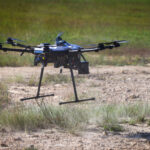The French, German, and Spanish defense ministries have committed to the next stage of the tri-national Future Combat Air System. Their signature on Phase 1B unlocks €3.2 billion for a thirty-six-month round of design and demonstration work. The agreement comes two weeks after negotiators settled the final work-share split. The French Directorate General for Armaments notified the prime contractors – Dassault Aviation, Airbus Defence and Space in Germany and Spain, Indra, and the engine joint-venture EUMET.
Created in 2017, the SCAF initiative seeks to field a family of systems that can stay ahead of threats through 2040 and beyond. Spain joined the project in 2019, giving the program three funding capitals and more political weight inside the European Union. The partners see the project as the centerpiece of a future pan-European air-combat network and as a hedge against dependence on non-European suppliers, as outlined in the Next Phase of the NGWS/FCAS Project.
Phase 1B moves the program out of PowerPoint and into hardware. The contract covers a flying demonstrator for the Next Generation Fighter, a remote-carrier test campaign, a secure combat cloud, and a dedicated propulsion rig for a new-build engine. It also funds the ground facilities, digital twins, and security accreditation needed to support those assets.
Intellectual-property sharing rules sat at the core of the 2022 talks. France demanded sole authority over the low-observable outer-mold dimensions because it already guards similar data on Rafale. Germany argued for baseline openness for home integration of electronic-support pods. Spain pushed for a common vault that grants any partner access to code once the integration authority certifies it. The final compromise created a tiered repository: each nation owns its sovereign modules but gives the others black-box access through standardized interfaces.
Digital infrastructure also makes a leap. The contract orders the firms to run a live, shared product-lifecycle environment instead of shipping files back and forth. The platform lives on an air-gapped cloud hosted in three mirrored data centers, one in each country. A low-latency fiber ring links the stacks, supporting real-time collaborative design sessions. That setup cuts days from fit-check cycles and ensures that every engineer sees the same frozen geometry, which is similar to the collaborative efforts in developing U.S. Collaborative Combat Aircraft.
Sensors and electronic warfare move to an open-architecture spine. Thales will supply software-defined apertures that can swap modes in milliseconds. Indra’s team will weave them together through time-sensitive networking, letting the fighter switch from radar to electronic attack without different hardware. The ministries insist on native anti-spoofing encryption that stands firm in GPS-denied theaters.
Sustainment edges into design logic. The airframe team intends to swap line-replaceable units at flight-line level within thirty minutes. The partners placed maintainability up front. They expect that decision to halve life-cycle cost compared with present aircraft.
Key tasks in Phase 1B:
- Build the full-scale fighter demonstrator’s primary structure and start assembly jigs.
- Fabricate and bench-test an instrumented core engine.
- Fly at least two remote-carrier prototypes, one released from an A400M transport and one from a fast-jet testbed.
- Stand up the first sovereign tactical-cloud lab linking Rafale, Eurofighter, and space-based nodes.
- Validate a low-observable radome and an adaptive data-link waveform.
Dassault will direct the airframe stream. Airbus Germany will steer the system-of-systems architecture and lead the remote-carrier campaign. Indra will keep the overarching combat cloud on schedule, while EUMET – Safran Aircraft Engines and MTU Aero Engines – carries full responsibility for the engine core.
The industrial roster, although still evolving, already assigns heavy work to dozens of second-tier suppliers:
- Airframe: Dassault Aviation, Airbus Defence and Space (Germany), Airbus Defence and Space (Spain).
- Propulsion: Safran Aircraft Engines, MTU Aero Engines, ITP Aero.
- Sensors and fusion: Thales, Indra, FCMS.
- Weapons integration: MBDA.
- Networking and cyber: Satnus, Airbus Secure Communications.
The three governments preserved a simple funding split: France pays 42 percent, Germany 34 percent, Spain 24 percent. The capitals ring-fenced the cash inside multiyear spending laws, preventing later votes from raiding the budget.
The design teams in Saint-Cloud and Ottobrunn loaded four digital configurations into the common design environment. Each meets the 11-ton empty-weight target and crosses Mach 2 on military power. Engineers will run a side-by-side wind-tunnel series early in 2023 to rank the options by signature, range, and agility. The first down-select is tied to the fighter-cockpit review in mid-2023.
Engine planners advanced at a similar pace. Safran’s Villaroche site cast single-crystal turbine blades for a scaled core and planned the first combustor-rig trial within the year. MTU’s Munich team machined adaptive stator vanes rated for 1,950 K turbine-inlet temperature. Both companies aim at a six-to-one pressure-ratio fan and a twelve-stage high-pressure compressor.
The remote-carrier branch follows two lines of attack. One path focuses on disposable decoy and jamming pods. The other targets reusable loyal-wingman drones with internal bays for precision weapons. Airbus and Diehl have already flown a drop test from an A400M ramp to prove release clearance. A second test from a modified Eurofighter twin-seater will follow in 2023.
Unlike legacy projects, SCAF treats its combat cloud as a primary weapon. The cloud will host the mission-intelligence backbone and allow real-time target files to move across platforms. The first secure node, running on militarized Kubernetes clusters, will feed live data from French Syracuse satellites to the Rafale testbed next spring.
Political support, for now, looks solid. The Bundestag placed the first tranche of German money inside the 2023 federal-finance plan. In Paris, the Assemblée nationale cleared the out-year authorizations by a wide margin. Madrid passed a supplementary credit bill that locks in its share until 2026.
Each capital has its advantages:
- Paris points to strategic autonomy, export-control freedom, and local high-tech jobs.
- Berlin sells the project as an anchor for the aerospace Mittelstand beyond 2035.
- Madrid frames the work as a way to raise local content in future Eurofighter upgrades.
The contract’s schedule lists thirty-two milestones. The most visible is the fighter-demonstrator’s first flight, planned for late 2028. The partners want the reusable remote carrier airborne a year earlier and the engine demonstrator on a flying test bed by mid-2027. The cloud must gain initial security accreditation inside the same window.
One clause calls for “early operational experimentation” with assets already in service. In practice, that means linking a Rafale, a Luftwaffe Eurofighter, and Spanish Army sensors through the newborn cloud during exercise Orion23.
Cost control remains the most acute risk. The public contract hides most industrial rates, but office notes put the weighted average engineering rate at €114 an hour. A one-percent drift inflates Phase 1B by nearly €30 million. Finance chiefs built a dual-key system: the program office may re-allocate up to €150 million without a governmental vote; bigger changes go before national oversight committees.
Environmental pressure has not eased. Climate groups lobby to cut military emissions during peacetime flights. The ministries say the new fighter will emit less CO₂ per combat effect than Rafale or Eurofighter thanks to an adaptive-cycle core and sustainable-fuel compatibility. They stop short of promising carbon neutrality, yet they commit to a life-cycle assessment by 2026.
Export politics sit in the background. France guards its Rafale market. Germany and Spain watch Eurofighter orders. The ministries agree that the SCAF fighter should remain off the open market for at least five years after entry into service, with exceptions for “trusted partners.” The political backing remains strong, as Europe’s Future Combat Aircraft advances toward demonstrator flights, ensuring its role in future defense strategies.
The presence of two European sixth-generation initiatives raises eyebrows. The rival Global Combat Air Programme, led by the United Kingdom, claims similar milestones. Analysts say the continent can afford two lines if political friction stays low and if the projects share basic research. The overlap still introduces risk and complicates supply chains.
For now, the three capitals echo the same stance: stay the course, meet the 2040 fielding date, and keep critical technology inside Europe.
WHAT’S NEW – MARCH 2025 UPDATE
March 2025 finds the SCAF machinery in full stride, halfway through Phase 1B and close to its midpoint design review. The tri-national board met in Toulouse last week and endorsed the first composite lay-ups for the fighter demonstrator’s center fuselage. Dassault technicians installed the keel beam on time after a ninety-six-hour cure – welcome progress after earlier tooling delays. Airbus froze the outer-mold-line geometry, ending a year-long debate over wing-twist distribution.
Digital engineering paid off. With four airframes in the model, the board measured fuel fraction, internal volume, and radar cross-section against mission tapes. Two designs cleared all gates, and the joint committee asked the chief engineer to drop the other two. The final choice now shifts to April, when the governments will pick the single airframe to fly in 2028.
Engine work advanced as well. Safran fired its instrumented core at Villaroche in February, reaching 45 percent of target thrust on the first run. Flame stability stayed within limits, and telemetry showed uniform exhaust patterns. MTU shipped the variable-area nozzle prototype to France after thermal-shock trials in Oberpfaffenhofen. The team targets full-rated thrust tests before autumn.
Remote-carrier trials moved into flight. Airbus and Diehl released two Do-DT25 test drones from a Luftwaffe A400M over the Baltic in September 2024 and January 2025. Both sorties proved safe separation, engine start, and autonomous navigation. The second flight pushed further, handing control to a ground station near Laage for a simulated strike run. Data links held through active jamming, validating the frequency-hopping scheme Thales built into the prototype.
Cloud experiments followed. During exercise Atlantic Shield in February, a French E-3F passed live tracks to a Spanish F-18M through the experimental combat cloud, which in turn forwarded data to a German sky-shield radar. Latency averaged 1.8 seconds, well below the three-second ceiling.
Money stayed on track. The French National Assembly passed the 2025–29 military-planning law in December, keeping the SCAF line item intact. The Bundestag released the second German tranche in January after an audit graded cost control “acceptable.” Spain’s coalition survived a confidence vote tied to defense spending, freeing the treasury to fund its share through 2027.
Cracks did appear. Dassault chief Éric Trappier told lawmakers that cooperation remains “complex” due to divergent industrial cultures. The comment hit the wires in mid-March but caused less shock than earlier spats. Insiders say the partners finally have a dispute-resolution matrix that routes design rows to technical boards instead of political offices.
Looking ahead, Phase 1B has eighteen months left. The fighter demonstrator’s wing-carry-through section should mate with the forebody by November. The engine core will climb to 75 percent thrust by year-end. Remote-carrier sortie number three aims to eject a glide decoy at Mach 0.8 from a Eurofighter two-seater in December. The ministries plan to open Phase 2 funding talks during the EU defense-ministers council in October. If schedules hold, contract award could arrive in mid-2026.
REFERENCE SOURCES
- https://www.safran-group.com/videos/zoom-engine-mock-ngf-future-european-combat-aircraft
- https://www.airbus.com/sites/g/files/jlcbta136/files/2022-12/en-joint-press-release-fcas-demophase-1b-contract_0.pdf
- https://www.edrmagazine.eu/fcas-a-major-european-defense-program-marking-the-transition-to-the-era-of-collaborative-combat
- https://breakingdefense.com/2023/11/fcas-weighing-4-fighter-designs-could-make-final-choice-by-march-2025/
- https://www.flightglobal.com/defence/eumet-joint-venture-powers-ahead-with-work-on-engine-for-fcas-fighter/155888.article
- https://aviationweek.com/shownews/gascc-riat/europes-future-combat-aircraft-advances-toward-demonstrator-flights
- https://www.defensenews.com/global/europe/2024/06/06/airbus-diehl-aim-at-future-air-war-with-drone-wingman-remote-carrier/
- https://www.flightlineweekly.com/post/remote-carrier-demonstrator-released-and-operated-from-flying-a400m
- https://www.defensenews.com/global/europe/2025/04/11/dassault-ceo-strikes-dark-tone-on-europes-sixth-gen-fighter-progress/
- https://www.defenceiq.com/air-forces-military-aircraft/articles/the-fcas-programme-explained-a-beginners-guide



